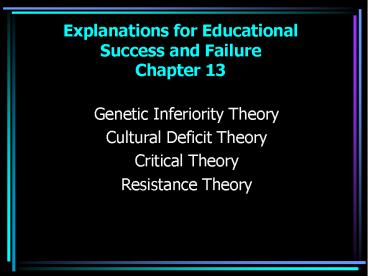Explanations for Educational Success and Failure Chapter 13 PowerPoint PPT Presentation
Title: Explanations for Educational Success and Failure Chapter 13
1
Explanations for Educational Success and
FailureChapter 13
- Genetic Inferiority Theory
- Cultural Deficit Theory
- Critical Theory
- Resistance Theory
2
Genetic Inferiority Theory
- They appeal to the self-images of those judged to
be superior - The genetic or biological argument has been
repeatedly used to rationalize the suppression of
racial minorities, females, and people from lower
socioeconomic classes - Myth of the IQ score
- Scientific appearance makes it seem even more
convincing
Jensen and Hernstein studies assumptions IQ
tests are valid measures of intelligence,
intelligence is mainly inherited, lower IQ tests
indicate that African-Americans are less
intelligent and therefore less educable than
whites. Poverty therefore results from inherited
deficiencies in the poor, not from unequal school
and employment opportunities Criticisms of
Jensen and Hernstein study IQ test scores
measure cultural knowledge from middle to upper
class families, not intelligence, no evidence
linking intelligence with heredity and the
database was an accumulation of old and flawed
data60 years old!!!!!
3
Cultural Deficit Theory
- Reasoning that children were not biologically
inferior but came from inferior home environments - Poor and minority children did not have the same
social, cultural, and intellectual opportunities
as middle-class white children - Did not participate on a daily basis in
sophisticated adult conversation as their (poorer
and less educated) parents were unable to prepare
them for school. - Reasoned that these children were victims of
linguistic or cultural deficiencies. - Poorer and African-American children were not
prepared for kindergarten as their white
counterparts werehad attended preschools - Ill prepared to enter schoolcould not count,
read, and name colors. - SUPPORT
- Evidence supporting this theory
- Left existing social and cultural arrangements
intact - Located problem of low achievement in students
home culture - Pointed a way toward a solution-society needed to
provide remedial education to older students and
compensatory/preventative schooling for young
children - SOLUTION
- Head Start Program
4
Criticism -Dominant culture is assumed to be
legitimate. Does not call into question its
privileged status as the norm. -Minority
children are tested and evaluated using the
language and social knowledge of the dominant
culture. This is a disadvantage. -Standardized
testing procedures do not test for the
competencies developed in other cultures and
linguistic systems. -Not a single American
culture but numerous cultures intermingling,
competing and informing one another.
5
CRITICAL THEORY
- Calls into question the whole social order and to
use various viewpoints in discussing a given
problem. - Argues that inequalities in educational outcomes
are a reflection of inequalities in larger
society. - Looks at the relationship between the child and
the school as the primary unit of analysis. - Looks at the relationship between the childs
culture and the culture of the school in an
effort to assess conflicts. - When a conflict between child and school is
identified, it is treated as a mismatch between
the culture of the student and the culture of the
school - Cultural Difference Theory
- Respects the variety of human cultures and
assesses the relationships among various cultural
groups. - Cultural Mismatches can occur with respect to
subject matter, learning styles, ways of knowing
and demonstrating knowledge, attitudes toward
authority, modes of behavior, and socialization. - Cultural differences, not cultural deficits
6
- Cultural Mismatches can occur with respect to
subject matter, learning styles, ways of knowing
and demonstrating knowledge, attitudes toward
authority, modes of behavior, and socialization. - Cultural differences, not cultural deficits
- Cultural Subordination Theory
- Examines the social processes that lad to lower
status for minority groups. - Examines the inequalities that appear to be
structured in to the social system - Applied to relations between dominant and
subordinate racial and ethnic groups as well as
between gender relations and social class
relations.
7
- Jean Anyon Study-found a direct relationship
between quality of schooling and social class. - 5 modern elementary schools in New Jersey.
Found - Working Class Schools-children found to be
relatively indifferent to academic content beyond
the basics. Teachers rated students as lazy and
not knowing anything. Instruction was by rote
learning and repetition. Teachers insisted
students follow set ways of doing things.
Students developed a very clear sense of how
knowledge is createdfrom books - Middle Class Schools-Teachers concentrated on
helping students develop advanced intellectual
skills (vs. only basics), learn from experience,
think for themselves, make decisions, take risks,
test hypothesis, individualism is emphasized. - Executive Elite School-Teachers said these
children would go to the best schools so we have
to prepare them. High expectations, debates,
conservative view of knowledge, competitive,
confident, sophisticated in their mastery of the
school environment.
8
Resistance Theory
- Students experiencing discriminatory practices
often reject or resist the authority of schooling
thereby contributing to their own failure
(examples on p. 414) - Rejection of schooling/academic workschool seen
as irrelevant to their goals - Acting dumb
- Peer sanctions
- Failure is seen as a statement of the irrelevancy
of schooling

